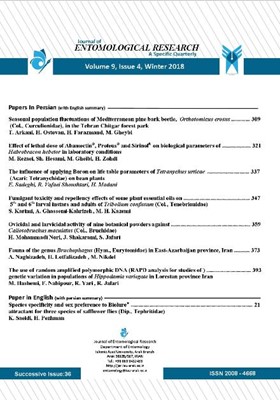The use of random amplified polymorphic DNA (RAPD) analysis for studies of genetic variation in populations of Hippodamia variegate (Col.:Coccinellidae) in Lorestan provinces, Iran
Subject Areas : entomology and othea arthropods
M. Hashemi
1
![]() ,
F. Nabipour
2
*
,
R. Yari
3
,
R. Jafari
4
,
F. Nabipour
2
*
,
R. Yari
3
,
R. Jafari
4
1 - Department of Biology, Faculty of Sciences, Borujerd Branch, Islamic Azad University, Borujerd, Iran
2 - Young Researchers and Elite club, Khorramabad Branch, Islamic Azad University, Khorramabad, Iran
3 - Department of Biology, Faculty of Sciences and Faculty of Agriculture Science, Borujerd Branch, Islamic Azad University, Borujerd, Iran
4 - Department of Biology, Faculty of Sciences and Faculty of Agriculture Science, Borujerd Branch, Islamic Azad University, Borujerd, Iran
Keywords:
Abstract :
Hippodamia variegata is one of the major predators of crop pests which feed an aphids and psyllids. RAPD is a useful genetically marker to determine polymorphism and relationship among LadyBirds species. The aim of this study was to identify and study the genetic diversity of Hippodamia variegata Goeze (Col.:Coccinellidae)in 9 natural populations and 2 commercial breeding populations. To investigate the genetic diversity of 8 primers, 10 randomized nucleotides (C-15, C-16, C-18, C-19, BE-03, BE-09, B-01, B-06) were used. All primers created clear and repeated bands. Of the 147 bands produced, 82 bands, 55.78 percent, were polymorphic. The length of amplified fragments by all primers varied from 225 to 2000 base pairs. The dendrogram was calculated based on the Jaccard similarity coefficient by UPGMA method. The results of cluster analysis indicated that there was a high genetic difference among the populations studied in Lorestan province. Primer BE-09 (28 bands) produced the highest and primer C-16(13 bands) produced the lowest number of bands. Two populations Dorud and Kuhdasht formed the first cluster close to 0.28 Jaccard coefficient of using UPGMA method. Other clusters formed a very low percentage of similarity. This shows that the susceptibility of the ecology and geography of the province despite the small size establishes and maintains the genetic diversity in the province of the ladybirds. The results of cluster analysis indicated high genetic differences between populations studied in the Lorestan province.
_||_

